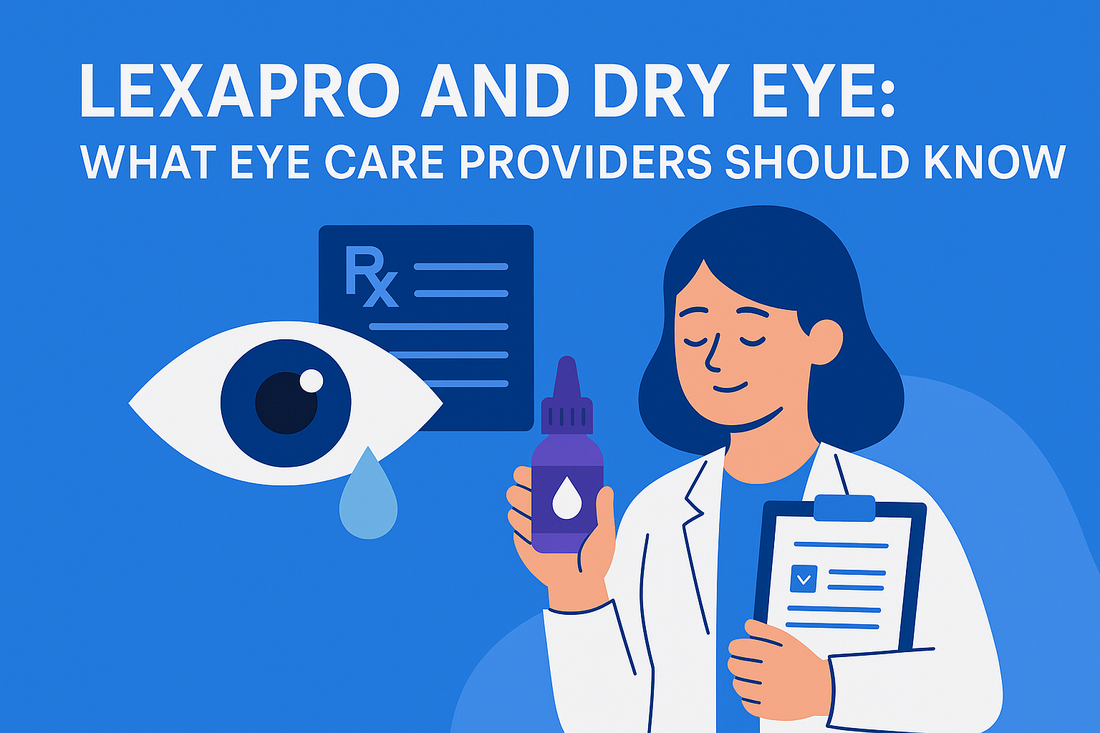Quick Summary:
Lexapro (escitalopram), a widely prescribed SSRI used to treat depression and anxiety, has been linked to dry eye symptoms in a significant number of patients—especially women and contact lens wearers. If you’re seeing Lexapro on a patient’s intake form, it’s worth asking, not how their vision is, but how their eyes feel. In this article, we’ll walk through why Lexapro may contribute to dry eye, what the research says, and how to talk to patients about managing the symptoms.
Why This Matters in Practice
With more than 21 million Americans prescribed Lexapro, this isn’t a niche issue. Yet many patients and even some providers don’t associate antidepressants with eye discomfort. That means dry eye symptoms often go unreported—and untreated.
If your patient is describing burning, gritty, or fluctuating vision and they’re taking Lexapro (or any SSRI), there’s a good chance the two are related.
A simple question—"How do your eyes feel?"—can uncover something that isn't visible in a refraction or slit lamp exam.
What Is Lexapro, and How Does It Work?
Lexapro, or escitalopram, is a Selective Serotonin Reuptake Inhibitor (SSRI). It works by increasing serotonin levels in the brain to help regulate mood and anxiety. It’s often chosen because it causes fewer side effects than older antidepressants.
But serotonin receptors aren’t just in the brain. They’re also found on the surface of the eye, in the cornea and lacrimal glands, and throughout the nervous system that helps regulate tear production. That’s where the trouble can start.
How Lexapro Can Contribute to Dry Eye
Lexapro may cause or worsen dry eye through a couple of different mechanisms:
1. Reduced Tear Production
SSRIs like Lexapro affect the parasympathetic nervous system, which plays a role in stimulating tear secretion. When this system is suppressed, the aqueous layer of the tear film becomes compromised. That can lead to dry, irritated, or burning eyes—especially in patients who already have borderline tear production.
2. Changes to Ocular Surface Sensitivity
SSRIs may also alter nerve signaling in the cornea, which can change how the eyes perceive discomfort. This doesn’t always mean less sensitivity. In some cases, patients become more aware of dryness or irritation, even if the eye doesn’t appear clinically inflamed.
Some studies estimate that up to 30% of patients on Lexapro report dry eye symptoms, though it's likely underreported due to lack of awareness on both sides of the exam chair.
Who’s Most at Risk?
Anyone taking Lexapro may experience some level of dryness or discomfort, but certain patients are more likely to feel the effects:
-
Women, especially post-menopausal patients
-
Contact lens wearers, whose eyes are already under more stress
-
Patients with underlying dry eye or MGD, where Lexapro adds another layer of dysfunction
-
People working long hours on screens, with reduced blink rate
If any of these apply, be proactive. Ask about eye comfort—even if the patient hasn’t brought it up.
What Can You Recommend?
1. Preservative-Free Artificial Tears
Daily use of a gentle, preservative-free drop can help stabilize the tear film and reduce surface irritation. Products like Peeq Pro Preservative-Free Eye Drops are designed for frequent use and help rebuild moisture without irritating the ocular surface.
2. Lid Hygiene and Inflammation Control
Dry eye isn’t just about tear volume—it’s also about inflammation and eyelid health. Recommend a daily lid cleanser like Peeq Pro Lid & Lash Cleanser to reduce bacteria and maintain gland function. This is especially helpful for patients with signs of blepharitis or meibomian gland dysfunction
3. Hydration, Screen Breaks, and Lifestyle Adjustments
Encourage patients to stay hydrated, take regular screen breaks, and use humidifiers if they’re in dry indoor environments. These small changes can support tear film health and reduce discomfort.
If symptoms are moderate to severe, in-office treatments like thermal pulsation or IPL may be needed—but for many patients, a simple at-home routine goes a long way.
FAQs About Lexapro and Dry Eye
Is dry eye a common side effect of Lexapro?
A: Yes, it’s one of the more frequently reported ocular side effects of SSRIs, though it may not be listed prominently on drug information sheets.
Q: Will the dry eye go away if the patient stops Lexapro?
A: Possibly, but not always. It depends on how long the patient has been on the medication and whether the tear glands have been compromised. Also, for most patients, stopping Lexapro isn’t an option without significant trade-offs. So the goal is usually to manage symptoms effectively while continuing the medication.
Q: Can I report dry eye as a side effect to the prescribing doctor?
A: Yes, and many psychiatrists or primary care physicians appreciate the feedback. It helps them support the patient more holistically and may lead to adjustments in dosage or drug choice if needed.
Final Takeaway for Eye Care Providers
Dry Eye isn’t always caused by one's environment or age. Medications—including SSRIs like Lexapro—can play a significant role. As an eye care provider, your ability to spot this connection and guide patients through it is essential.
Start by asking how their eyes feel. Look at their medication list. Explain the connection. Then recommend a plan that works—whether that’s preservative-free drops, lid care, or a combination of both.
At Peeq Pro, we support clinicians and patients with dry eye solutions that are backed by science and built for everyday use. If you’re looking for a reliable way to help patients manage medication-related dry eye, we’re here to help.

